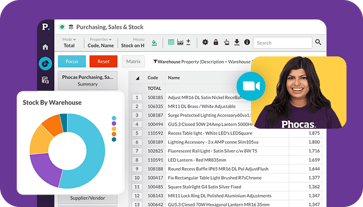Don't go back. Get your digital transformation strategy 2.0 ready
A digital transformation strategy can be defined as the way a company implements and uses technology and analytics to differentiate itself, operate better and compete more effectively. Many businesses knew prior to the pandemic that they were in need of a digital upgrade - now it's imperative and mid-market managers need to consider data analytics as an essential way to make the transformation to a digital business.
Data analytics has a low barrier to entry
Modern solutions do not require big project commitments of time and head count. Since these solutions are offered as out of the box, they provide an intuitive interface and integrate seamlessly with a variety of enterprise resource planning solutions and other data sources.
Key to the success of these technologies is the fact that many are built for users of all skill levels. Gone are the days of dedicated product specialists and teams focuses solely on managing Excel spreadsheets and reporting for the entire company. Support is minimized and broad deployment and integration can be done in bite-sized chunks. Companies can start small and then scale up, adding more data sources and users as they go and as needed.
The need for accurate and timely data has never been greater
With so many uncertainties and questions about the future, teams need accurate and timely data from a single source of truth so they can perform with confidence.
Your business generates data from dozens of sources, including customers, inventory management, warehouse operations, sales and customer service, and more. When different departments use separate systems, it can lead to data integrity problems, multiple versions of spreadsheets and reports that don’t represent a true and complete picture. It’s essential to collect data from your various sources and aggregate it into one central system that is quickly and easily accessible.
With a trusted source of data, you can develop a strategy around data- driven decision making, allowing teams
to focus their attention and quickly assess situations. Armed with the right information, they can react faster, address many interdependent issues simultaneously, and make decisions across all parts of the business.
Finance teams -
Traditionally, finance leaders do not allow many people to access ERP or corporate financial data due to the risk of submitting incorrect entries or corrupting the data. Armed with the power of data analytics and with access to the right financial information, members of the finance team can quickly manipulate and share financial information for all divisions’ reporting needs to enhance the speed of decision making.
Inventory teams -During COVID-19, monitoring inventory levels has never been more important as production delays, extreme demand and logistic challenges combined to create a perfect storm for many businesses. With data analytics, inventory managers can spend more time building scorecards, running reports and tracking inventory, so that everyone can react faster to the changing environment and needs of customers.
Data analytics is the backbone for ongoing transformation and a new way of operating
Companies that want to compete effectively and profitably in the current environment, as well as in the post-COVID world, will need data to make faster, more informed decisions. This mindset will require data analytics to be completely embedded in operations and the culture of the business. When this happens, data analytics can help:
-
Digitize and simplify processes in a variety of ways, from presenting information visually in easy-to- understand charts and graphs to eliminating the paper spreadsheet.
-
Broaden the skills and capabilities of people, enabling them with the information they need to make decisions and become more engaged in the trajectory of the business.
• Improve communications between departments by giving everyone access to a single source of truth that allows teams and departments to review, compare and analyze the same data.
Data analytics can also drive continuous improvement. As leaders and teams use data in their individual roles, they can track KPIs to determine the impact of their decisions on strategic goals and team, department and overall business performance. They will see how decisions based on accurate data can impact all aspects of the business, from inventory levels to the bottom line.


Myles is the co-founder and CEO of Phocas.
Related blog posts

Financial planning and analysis (FP&A) provides the insights that drive growth, protect profitability and guide new investments. Done well, FP&A transforms raw financial data into scenario models and forecasts, helping finance leaders and business units move ahead with confidence.
Read more
Picture a football coach preparing for the big game. He watches game‑tape, studying player metrics, analyzing every play and using real‑time stats to inform strategy. That’s exactly how sales managers and sales leaders should approach their coaching program—with a data‑driven approach.
Read more
Sales professionals operate in face-paced environments with savvy customers who have a lot of choice. Whether you're in B2B sales or working with consumers, the sales process is challenging with longer sales cycles, more decision-makers and higher expectations for follow-up and advice. To stay competitive, sales reps and sales teams need the best sales tools to reduce administrative tasks and improve sales team performance.
Read more
“Free BI tools trial, business analytics software for free, free BI reporting with AI-powered insights”– these offers are tempting business people all the time especially as new open-source players enter the market and want cut-through.
Read moreBrowse by category

Find out how our platform gives you the visibility you need to get more done.
Get your demo today